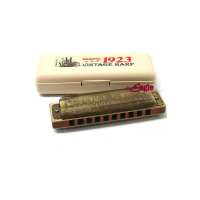
REVIEW OF THE HERING 1923 VINTAGE HARP The first thing to strike me when I picked up the new Hering Vintage Harp was its weight. Despite its being almost identical in dimension and styling to the HM Hohner Marine Band the Vintage harp is a good ounce heavier. The majority of this weight is accounted for by the extra-thick reedplates on this model that bear much of the responsibility for the superior tone of this instrument as well as contributing to the feeling of ‘quality’. The cover plates are very similar in size and shape to those of the Marine Band and are similarly unsupported at the rear. They are coated with a bronze-effect lacquer that is extremely smooth and very hard wearing and has, to my mind, the beneficial effect of reducing friction and thus aiding fluid and comfortable playing. The cover plates are attached with two sturdy brass screws and nuts. As I mentioned before the reedplates are very thick and they are attached to the comb with five brass screws. The reeds are riveted to the reedplates. Finally the comb is made from wood and is coated with a high quality, exceptionally smooth varnish on all external surfaces. The horizontal surfaces of the comb upon which the reedplates sit have been finished to a much higher than usual standard as the minor imperfections created when sawing the wood for the comb that are a major cause of air-leakage have been removed. The teeth of the comb are slightly more recessed from the face of the harp than is the case with the Marine Band which to my mind makes the instrument more comfortable for the player. After repeated playing I found absolutely no evidence that the comb had swelled. Tuning of this harmonica is the same as most other Hering diatonic harps and follows the ‘just intonation’ method. If a harmonica is tuned to equal temperament the each reed is tuned in the same way, i.e. if you were to check the pitch of each reed with an electronic guitar-tuner each note would register, for the sake of this example, two cents above concert pitch. This method of tuning makes most chords played on the harmonica sound harsh and unpleasant. The just intonation approach involves flattening the pitch of some reeds in relation to the others in order to make the chords sound sweeter. To cut this ramble short, just intonation is great for blues playing as the all-important chords in the first octave sound full and rich and the heavily flattened 5-draw reed sounds really ‘bluesy’. All the great blues harpists of the ‘20s, ‘30s, ‘40s, ‘50s and ‘60s used harps with this tuning and the Vintage Harp really is an ideal choice for the player of ‘traditional’ blues. Personally I prefer the 5-draw reed to be a little sharper than the two cents below concert pitch to which it is set on this harp but it took me no more than five minutes to tune it up slightly. I did have to re-gap the draw reed in hole one slightly as it was sitting a little too high from the reedplate causing it to rattle against the cover plate when played but again this took only a matter of minutes due to the ease with which this harp can be dismantled and re-assembled. The responsiveness of all the reeds was uniformly excellent and the tone full and strong in all three octaves. The Vintage Harp performed superbly in first, second and third position when I gigged with it, easily meeting all the demands placed upon it. In closing I would say that the Vintage Harp is an outstanding blues instrument that I have no reservation in recommending to the serious player. It is, in terms of quality streets ahead of similar, similarly priced instruments and is comparable in playability to expensive ‘custom’ harps. The harp is available in all keys. Spare reedplates are available. They are available in the following keys C, Db, D, Eb, E, F, F#, G, Ab, A, Bb, B.
Visit Product Page
